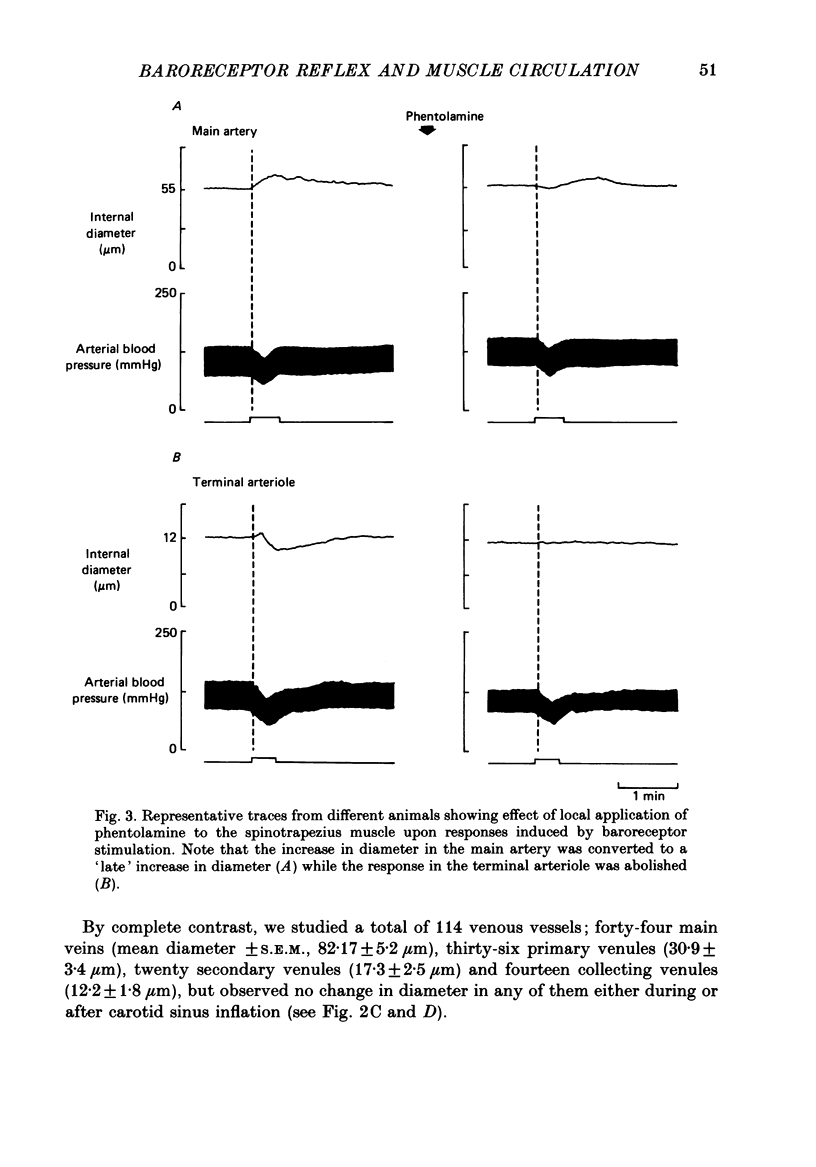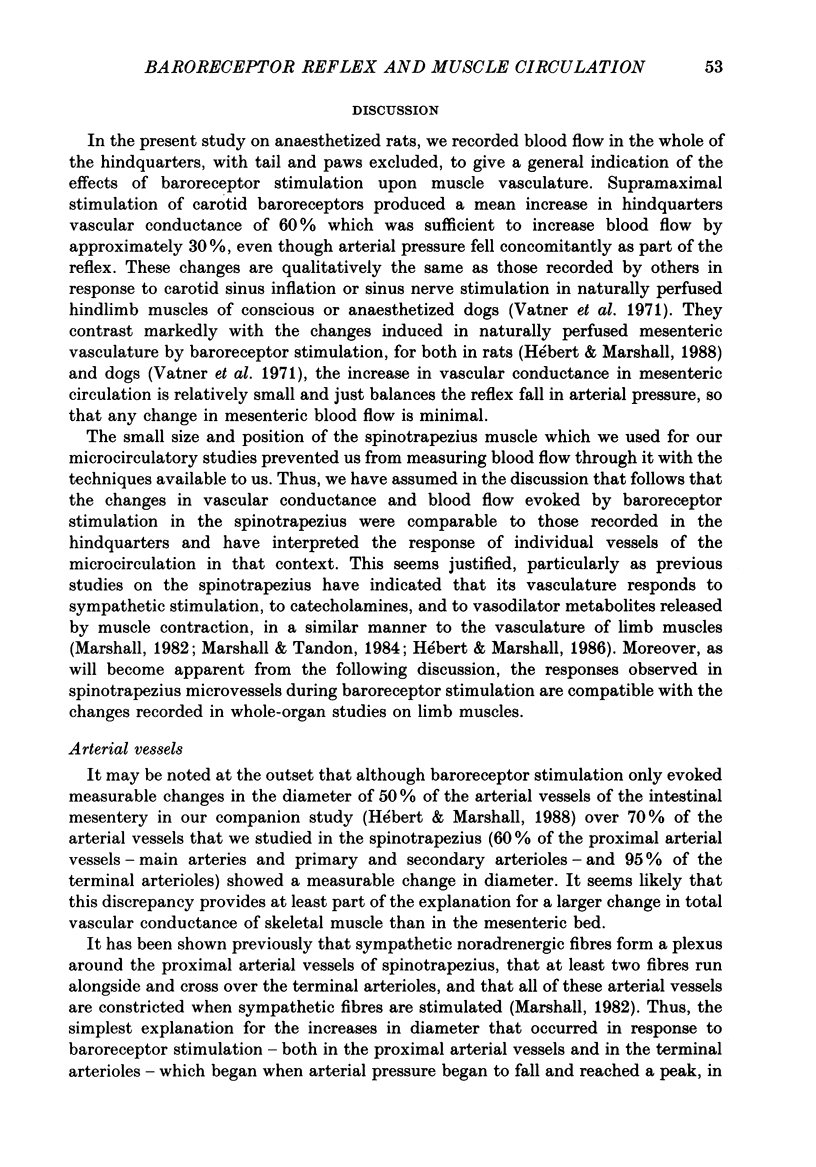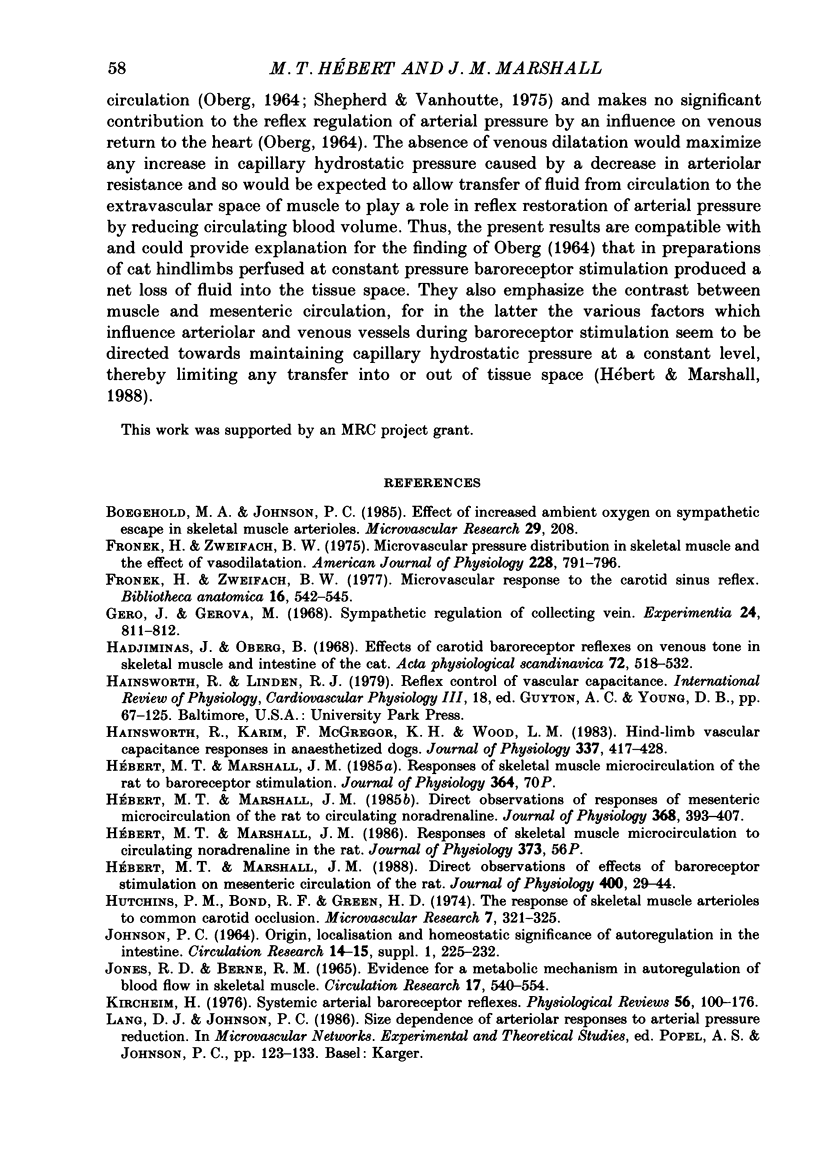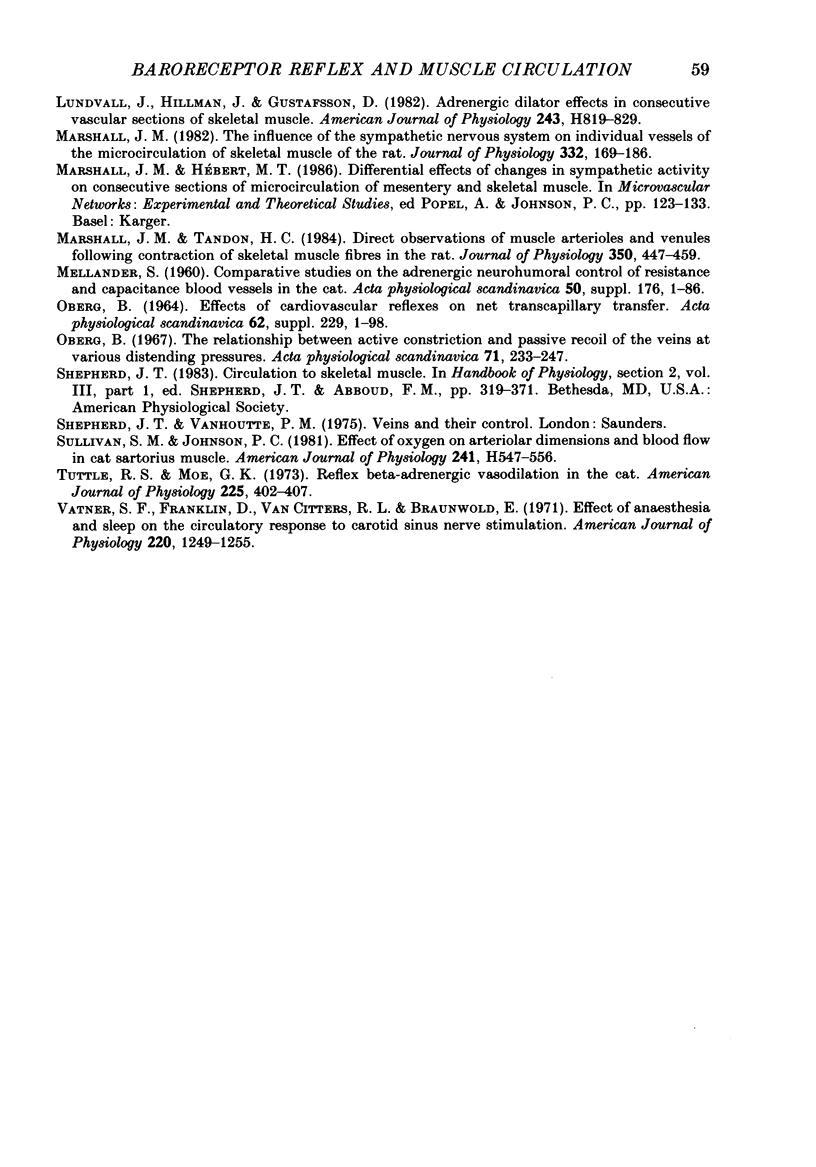Abstract
1. In anaesthetized rats, supramaximal baroreceptor stimulation by carotid sinus inflation evoked a reflex fall in arterial pressure and an increase in vascular conductance and flow of muscles of the hindquarters. 2. Simultaneously, main arteries, primary and secondary arterioles (13-90 microns, internal diameter (i.d.)) and terminal arterioles (7-13 microns) of the spinotrapezius muscle all showed a diameter increase that reached a peak as arterial pressure neared its zenith; terminal arterioles then showed a diameter decrease to below control level. These responses were abolished by local application of phentolamine or guanethidine to the spinotrapezius, or by crushing the paravascular nerve supply. 3. It is suggested that the diameter increases were mediated by reflex inhibition of sympathetic tone, while the secondary diameter decrease in terminal arterioles was induced by a fall in local concentrations of vasodilator metabolites, caused by an increase in muscle blood flow. 4. But after sympathetic blockade 25% of all arterial vessels showed a diameter increase beginning as the fall in arterial pressure neared its zenith. These responses may be attributed to vasodilator metabolites accumulating as a consequence of a reduction in muscle blood flow secondary to the reflex reduction in perfusion pressure. 5. No venous vessels, from venules (9-18 microns) to main veins (65-130 microns) that drain the muscle, showed a diameter change in response to baroreceptor stimulation, in accord with evidence that they have no sympathetic supply. 6. These results accord with and can provide explanation for changes in blood flow, regional blood volume and capillary filtration evoked by baroreceptor stimulation in studies on whole-limb muscle. They support suggestions that active changes in capacity of venous vessels of muscle play a minor role in the baroreceptor reflex; both active and passive changes in vascular capacity may be due to large veins outside of muscle proper.
Full text
PDF














Selected References
These references are in PubMed. This may not be the complete list of references from this article.
- Fronek K., Zweifach B. W. Microvascular pressure distribution in skeletal muscle and the effect of vasodilation. Am J Physiol. 1975 Mar;228(3):791–796. doi: 10.1152/ajplegacy.1975.228.3.791. [DOI] [PubMed] [Google Scholar]
- Fronek K., Zweifach B. W. Microvascular response to the carotid sinus reflex. Bibl Anat. 1977;(16 Pt 2):542–545. [PubMed] [Google Scholar]
- Hadjiminas J., Oberg B. Effects of carotid baroreceptor reflexes on venous tone in skeletal muscle and intestine of the cat. Acta Physiol Scand. 1968 Apr;72(4):518–532. doi: 10.1111/j.1748-1716.1968.tb03876.x. [DOI] [PubMed] [Google Scholar]
- Hainsworth R., Karim F., McGregor K. H., Wood L. M. Hind-limb vascular-capacitance responses in anaesthetized dogs. J Physiol. 1983 Apr;337:417–428. doi: 10.1113/jphysiol.1983.sp014632. [DOI] [PMC free article] [PubMed] [Google Scholar]
- Hutchins P. M., Bond R. F., Green H. D. The response of skeletal muscle arterioles to common carotid occlusion. Microvasc Res. 1974 May;7(3):321–325. doi: 10.1016/0026-2862(74)90019-3. [DOI] [PubMed] [Google Scholar]
- Hébert M. T., Marshall J. M. Direct observations of effects of baroreceptor stimulation on mesenteric circulation of the rat. J Physiol. 1988 Jun;400:29–44. doi: 10.1113/jphysiol.1988.sp017108. [DOI] [PMC free article] [PubMed] [Google Scholar]
- Hébert M. T., Marshall J. M. Direct observations of responses of mesenteric microcirculation of the rat to circulating noradrenaline. J Physiol. 1985 Nov;368:393–407. doi: 10.1113/jphysiol.1985.sp015864. [DOI] [PMC free article] [PubMed] [Google Scholar]
- Jones R. D., Berne R. M. Evidence for a metabolic mechanism in autoregulation of blood flow in skeletal muscle. Circ Res. 1965 Dec;17(6):540–554. doi: 10.1161/01.res.17.6.540. [DOI] [PubMed] [Google Scholar]
- Kirchheim H. R. Systemic arterial baroreceptor reflexes. Physiol Rev. 1976 Jan;56(1):100–177. doi: 10.1152/physrev.1976.56.1.100. [DOI] [PubMed] [Google Scholar]
- Lundvall J., Hillman J., Gustafsson D. beta-Adrenergic dilator effects in consecutive vascular sections of skeletal muscle. Am J Physiol. 1982 Nov;243(5):H819–H829. doi: 10.1152/ajpheart.1982.243.5.H819. [DOI] [PubMed] [Google Scholar]
- MELLANDER S. Comparative studies on the adrenergic neuro-hormonal control of resistance and capacitance blood vessels in the cat. Acta Physiol Scand Suppl. 1960;50(176):1–86. [PubMed] [Google Scholar]
- Marshall J. M., Tandon H. C. Direct observations of muscle arterioles and venules following contraction of skeletal muscle fibres in the rat. J Physiol. 1984 May;350:447–459. doi: 10.1113/jphysiol.1984.sp015211. [DOI] [PMC free article] [PubMed] [Google Scholar]
- Marshall J. M. The influence of the sympathetic nervous system on individual vessels of the microcirculation of skeletal muscle of the rat. J Physiol. 1982 Nov;332:169–186. doi: 10.1113/jphysiol.1982.sp014408. [DOI] [PMC free article] [PubMed] [Google Scholar]
- Oberg B. The relationship between active constriction and passive recoil of the veins at various distending pressures. Acta Physiol Scand. 1967 Oct-Nov;71(2):233–247. doi: 10.1111/j.1748-1716.1967.tb03729.x. [DOI] [PubMed] [Google Scholar]
- Sullivan S. M., Johnson P. C. Effect of oxygen on arteriolar dimensions and blood flow in cat sartorius muscle. Am J Physiol. 1981 Oct;241(4):H547–H556. doi: 10.1152/ajpheart.1981.241.4.H547. [DOI] [PubMed] [Google Scholar]
- Tuttle R. S., Moe G. K. Reflex beta-adrenergic vasodilatation in the cat. Am J Physiol. 1973 Aug;225(2):402–407. doi: 10.1152/ajplegacy.1973.225.2.402. [DOI] [PubMed] [Google Scholar]
- Vatner S. F., Franklin D., Braunwald E. Effects of anesthesia and sleep on circulatory response to carotid sinus nerve stimulation. Am J Physiol. 1971 May;220(5):1249–1255. doi: 10.1152/ajplegacy.1971.220.5.1249. [DOI] [PubMed] [Google Scholar]


